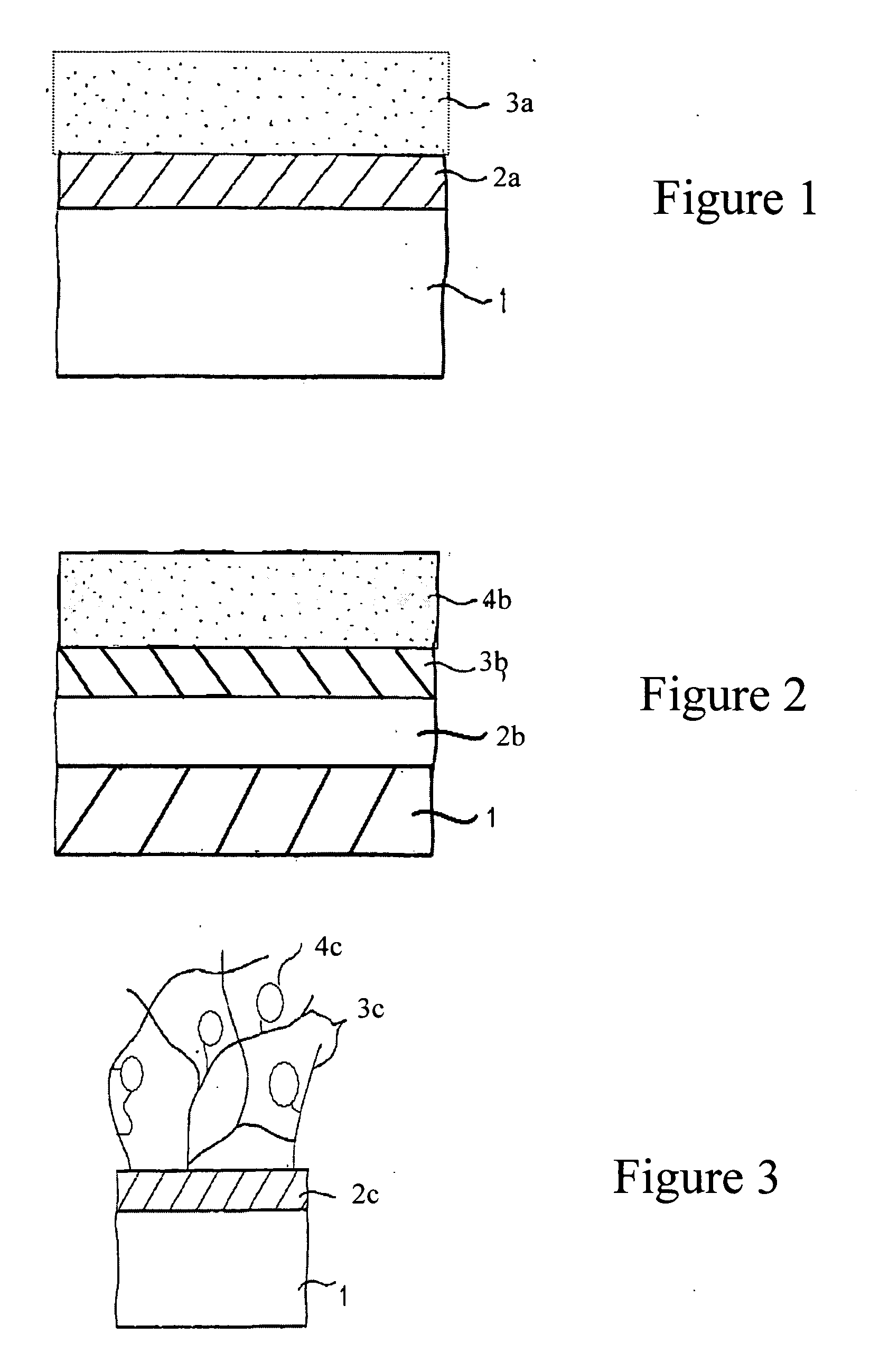Articles having bioactive surfaces and solvent-free methods of preparation thereof
a bioactive surface and solvent-free technology, applied in the field of articles having bioactive surfaces and solvent-free methods of preparation, can solve the problems of harming the surface being treated, denatured or damaged biologically active molecules being immobilized, and inability to have biologically active agents leach away in wet environments
- Summary
- Abstract
- Description
- Claims
- Application Information
AI Technical Summary
Problems solved by technology
Method used
Image
Examples
example 1
Deposition of Amine-Containing Silane onto Glass Substrates
[0062] The plasma treatment process to coat glass samples with polymerized monomer occurred in a 12-inch diameter by 18-inch tall upright cylindrical vacuum chamber. Glass samples were placed on a radio frequency powered 8-inch diameter electrode located at midplane of the chamber. An open 1-inch diameter by 2-inch tall vial containing about 5 cubic centimeters of APTMS was placed on the electrode. The system was initially evacuated by a turbomolecular pump, backed with a rotary vane roughing pump, to a pressure of about 8 milliTorr. The valve in the pumping line was then throttled back to allow the pressure of the vaporizing monomer to rise to a constant 85 milliTorr. The electrode was then excited by a 13.56 MHz radio frequency power generator, in series with a matching network to deliver 22 watts of power. The plasma so produced was operated for 60 seconds to polymerize the monomer vapor into a film on the surface of the...
example 2
Preparation of a Non-Fouling Surface on Glass-Bottom Plates
[0065] BD Labware 96 well glass-bottom plates (catalog #3537311) were exposed to an APTMS plasma as described in Example 1. A bioactive surface comprising polysaccharide (hyaluronic acid, Lifecore Biomedical) was subsequently covalently attached to the plasma coated surface of half of the wells of the plates using an aqueous EDC / NHS carbodiimide coupling chemistry. MC3T3 cells (mouse, osteoblast cells) were seeded into every well of the 96 well plate at 10,000 cells / well in 200 μL alphaMEM media containing 10% FBS. The section of the plate coated only with the APTMS showed significant cell adhesion and growth by 48 hours. The half of the plate coated with HA-coupled to the APTMS surface did not allow cells to attach within the same 48 hours. Thus, attachment dependent cells were unable to attach and therefore, could not grow or spread on the culture plate surface prepared in accordance with the methods herein described. Thu...
example 3
Preparation of a Glucose Biosensor
[0067] A glucose sensor was prepared at one end of a 400 μm core diameter optical fiber while the other end was coupled to a fluorescence detection device. The polished sensing end of the fiber was coated with APTMS as in Example 1. A bioactive surface comprising an alginate-based hydrogel matrix was coupled to the APTMS layer. The alginate hydrogel matrix was prepared by covalently cross-linking Pronova™ UP LVG alginate through the carboxyls with adipic acid dihydrazide (AAD), via carbodiimide chemistry. Pronova™ UP LVG was selected its low viscosity and high guluronic to mannuronic ratio. A 2% alginate solution was prepared by dissolving 1 gram of alginate into 50 mL 0.1 M MES buffer (pH 6.0) and adding 110 mg of AAD and 79 mg of hydroxybenzotriazole (HOBt). The solution can be stored at 4° C. until needed. To the alginate solution, 145 mg of 1-ethyl-3-(3-dimethylamino-propyl) carbodiimide (EDC) was added per 10 mL of solution, using a dual-syrin...
PUM
| Property | Measurement | Unit |
|---|---|---|
| temperature | aaaaa | aaaaa |
| temperature | aaaaa | aaaaa |
| power density | aaaaa | aaaaa |
Abstract
Description
Claims
Application Information
 Login to View More
Login to View More - R&D
- Intellectual Property
- Life Sciences
- Materials
- Tech Scout
- Unparalleled Data Quality
- Higher Quality Content
- 60% Fewer Hallucinations
Browse by: Latest US Patents, China's latest patents, Technical Efficacy Thesaurus, Application Domain, Technology Topic, Popular Technical Reports.
© 2025 PatSnap. All rights reserved.Legal|Privacy policy|Modern Slavery Act Transparency Statement|Sitemap|About US| Contact US: help@patsnap.com

